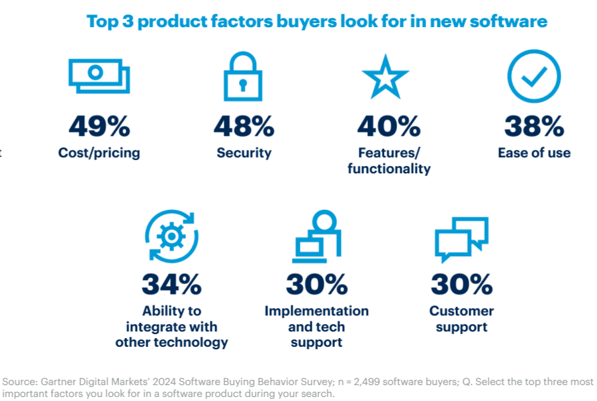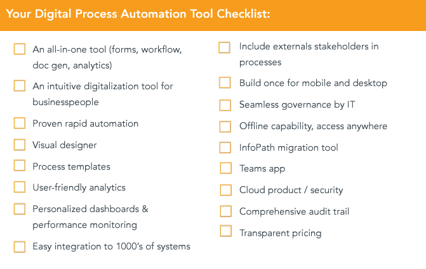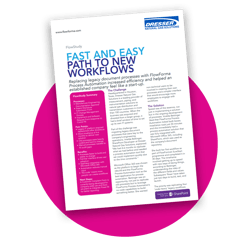Challenge #2: Building a business case
I regularly chat to people who want to undertake process automation, but with the number of stakeholders to impress with a business case, it can be a time consuming and challenging task and obviously a risk for the person who wants to take on the solution... but please don't let this get in the way.
Gartner Insights
The Gartner 2024 Global Software Buying Trends states that on average, the software evaluation process takes approximately 5 months, with a majority taking between 1 month to 6 months.

This Gartner report also states that the average buyer shortlist includes 4 providers and when searching for new software, the most important factors buyers look for are pricing and security.

Learn more about the future business process automation trends here.
Building the business case
So how can you effectively build your business case for successful process automation, here's some recommended steps to follow, which lots of vendors can support you on:
-
Define the problem: Think about the department/team you want to see success from, what are the complicated/time-consuming/time zapping repetitive tasks that are valuable to the business and list a few of those processes
-
Define the cost of the problem: Undertake an estimation of how much time is wasted or lost on these existing processes due to delays, errors, inefficiencies, lost paperwork/emails etc. and then calculate how much that costs the business
-
Research: Research automation tools using our handy checklist below
-
Undertake a cost analysis: calculate the costs involved, estimate the cost savings benefits and determine your Return on Investment
-
Plan: Pull together a view of project stakeholders and a roadmap to success
-
Present: Present the plan to stakeholders
 Challenge #3: Finding the ideal business process automation tool
Challenge #3: Finding the ideal business process automation tool
Selecting a DPA tool can be difficult, there are many choices, for example on Gartner Peer Insights, you’ll find 96 providers of process automation tools, while G2 lists 116 process management tools and 92 under Digital Process Automation.
From regularly supporting business improvement, transformation, and innovation leaders, FlowForma understands that there are certain considerations to bear in mind when selecting a new process digitalization tool.
To support you on this journey, here are some recommendations:
-
List your objectives and desired outcomes
-
Use a checklist, this will help you to identify your ideal Digital Process Automation tool
-
Test your shortlist of tools with a Trial or a Proof of Concept
-
Utilize G2, a trustworthy source that helps business professionals make better decisions
Tool Checklist

Challenge #4: IT skills shortage & automating business processes
 Another business process automation challenge is the global IT shortage of course. According to IDC, the IT skills shortage is expected to impact nine out of ten organizations by 2026 with a cost of $5.5 Trillion in Delays, Quality Issues and Revenue Loss.
Another business process automation challenge is the global IT shortage of course. According to IDC, the IT skills shortage is expected to impact nine out of ten organizations by 2026 with a cost of $5.5 Trillion in Delays, Quality Issues and Revenue Loss.
The report illustrates that 'a variety of cloud skills, including architecture, data management and storage, and software development, are among the ten most needed skills identified by survey respondents'.
A way to overcome this business process automation challenge is by using an intuitive digital process automation tool that can be used by use by either IT or business for digitalizing processes at speed.

Challenge #5: Change management
Change management is a common challenge that organizations have, there is always this worry when rolling out any new practice or software.
For example, over the years I've had construction companies worry about how staff who don't use computers daily would adopt Digital Process Automation, Financial services firms saying that some employees who were managing a specific process had been doing it one way for 20 years to mining companies who may have staff only using a laptop once a week. These are all common challenges across many verticals. But don't worry.... these change management worries can be addressed head out with some planning.
For example, our customers in mining, oil and gas and construction have tackled the change management issue with dispersed staff and those who don't regularly use laptops with a QR code solution, for example, one of our construction customers has QR codes on diggers, so that their staff or contractors can seamlessly access processes online via their mobile phones and quickly complete steps in their processes.
Quick wins are a great way to increase adoption, I can't say it any better than how William has described this below.
Challenge #6: Choosing the right business processes to automate
A common challenge of process automation initiatives is selecting the right processes to focus on. Each organization is different and so is its approach to automation, those who are onboarding a new tool will choose one of the following strategies:
-
a big bang approach whereby they automate 50+ processes and go live with a big batch of automated workflows on one day
-
a slow and steady approach whereby they will automate a handful of processes per month
-
a focus on high-value processes
-
a focus on automating complex processes
-
an immediate focus on digitalizing simple repetitive tasks that can be rolled out quickly
Processes for Big Impact
There is no wrong or right answer here, but we'd recommend you think about prioritizing the processes that would free up resources to focus on more strategic initiatives and aid the overall efficiency and effectiveness of your company.
Think about processes that are costly in terms of the number of hours and perhaps the number of employees it takes to execute. Are there processes that need to be completed to ensure you adhere to legislation? The opportunities are endless but consider which challenges to tackle first that will make a significant impact. Here are some of the business process automation use cases.

Challenge #7: Vendor Dependence
A challenge that can be faced with process automation is an over-dependence on a vendor or partner. I have heard of companies who use process automation tools that have very high complexity and are not intuitive enough for businesspeople to digitalize with, which means that they need to outsource a lot of their digitalization projects to the vendor or a partner, this can be a challenge regarding additional costs incurred and delays in waiting for the projects to be completed as they are relying on external resources. Another challenge with vendor or partner dependence is the lack of agility.
Customer Feedback
 One customer told me that FlowForma Process Automation as an intuitive no-code tool, made their organization very agile, for example when Covid-19 hit and there needed to be changes in their automated workflows, the process owners could quickly make the changes themselves.
One customer told me that FlowForma Process Automation as an intuitive no-code tool, made their organization very agile, for example when Covid-19 hit and there needed to be changes in their automated workflows, the process owners could quickly make the changes themselves.
Before implementing FlowForma, Imelda Bettinger commented that "the old processes took years to build and if our team needed a change, a request would be made and it would take a month before it was decided if it could actually be implemented".
Challenge #8: Employee Training and Skill Gaps
Companies may foresee process automation challenges regarding employee training and skills gaps with process automation solutions is employee training, I guess this is the same for onboarding any solution, but it shouldn't hold you back. From regularly chatting to companies about their onboarding journey with automation, it's clear that there is a huge appetite in businesses for process owners to want to digitalize their processes, and they want to digitalize these processes either on their own with a tool trusted by IT or in a fusion team with IT.
Customer Satisfaction
Our best customer success stories are those where a company will work with us on an employee training program where we run beginner and advanced training sessions for different personas. One customer of ours had 12 people trained on week one of onboarding our product and then within a year that group had automated over 120 processes, impressive work.
Forrester has compiled many great case studies on how companies have reaped the benefits of citizen development for automation initiatives and those that have done it best, have gone after citizen development energy, once you find the people in your company who have the appetite and energy to drive outcomes from digitalization, you are on the ideal path.
Challenge #9: Demonstrating ROI for tech investment
Luckily with digital process automation, organizations can be data-driven and report back to senior business leaders on:
- Productivity improvements
- Time saved
- Fines avoided (for compliance)
- Health and safety
- And much more
Challenge #10: Legacy technologies
Technology leaders are often in a position where they have inherited legacy technologies. One of the key challenges of business process automation is either replacing or integrating with these technologies.
Platforms such as FlowForma Process Automation can either replace or integrate with legacy technologies quickly and easily.
One example is the use of InfoPath, where support will stop in 2026. FlowForm has developed an InfoPath replacement tool that will map all of the data in InfoPath to FlowForma. This enables organizations to migrate over all data seamlessly to FlowForma and completely retire InfoPath when they are ready to do so.
Conclusion
As with anything, process automation comes with its positives, negatives, and concerns. I hope the information provided helps you navigate and overcome the automation challenges you may foresee or encounter during implementation. Interested in kickstarting your digital transformation journey? Request your 1-2-1 personalized demonstration from one of our business processes automation experts today and overcome your process challenges.
 By
By 






